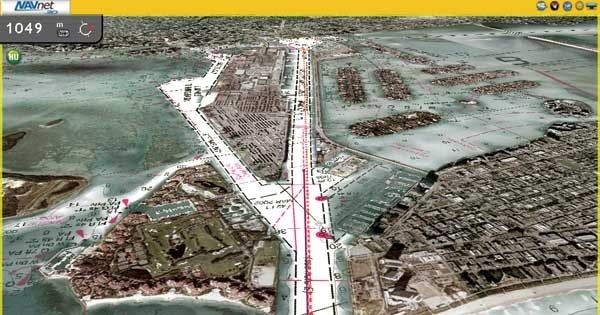
NOAA paper charts were eclipsed long ago on embedded chart plotters by the cleaner, more versatile vector charts. But the familiar old charts never went away entirely. PC navigation programs continue to take advantage of the strengths of the electronic version of the NOAA charts, and prudent mariners still keep a paper copy of the charts for their fishing waters tucked away in the console – don’t you? – as a backup. But chart plotter technology and the NOAA charts in electronic form never played particularly well together at the helm.
When navigational charts first went electronic, the information-rich NOAA charts had to be optically scanned – basically reproduced as a digital photograph. The scanning yielded huge, cumbersome raster files. They were not well suited to electronic display for a couple of reasons. Processor memory in those days was scarce and dear, and the big files were slow to load and slow to move on the display screen. The raster charts did not respond well to zooming in or to fast loading. Manipulation was out of the question. You got what you got on the screen, and if you zoomed in, pixels in the image got larger and resolution suffered.
Still, chart suppliers relied on these charts as a source when they set about tracing and transferring information into a different file format. The resultant vector files, 80 percent smaller than raster charts and more nimble, loaded quickly on chart plotters and allowed for layering of information on the screen. Because vector information is created by a mathematical formula instead of pixels, resolution and sharpness is perfect at all zoom levels. But early vector charts looked like crude comics, and skippers accustomed to the appearance of NOAA charts had to learn to trust the new format. That didn’t take long, and vector charting systems now are every bit as rich as the NOAA charts and a lot more versatile. The layers can be turned on or off at the helm to display the desired features without the clutter of everything else on the chart, and resolution remains constant no matter what the zoom level.
Both chart suppliers – Navionics and C-Map, which provide charts for a number of manufacturers’ chart plotters – and the proprietary, brand-specific developers, Garmin and MaxSea (Furuno) have honed vector cartography to a high art. Along the way, they added satellite imagery, 3-D display and configurations tailored for fishermen – and that’s the power of vector charts. While there is some residual feeling of comfort and security in the appearance of the original NOAA charts, vector charts are the name of the game and have been for a long time. It’s what we are all used to looking at.
“Raster data is dumb data, and vector is smart,” says Ken Cirillo, business-development executive for C-Map. “The power of vector far surpasses the raster chart. We have a vector database that includes all the paper-chart information taken apart, digitized and then put back together again [in vector format].”
So all the same information is there; it just looks a little different, and it cooperates a lot better for specific navigation and fishing purposes.
Another advantage of the vector format is the ease with which it is corrected and updated, so keeping charts current and accurate is never a long-term proposition. Regular updates are an established program for most chart suppliers.
Ease of use has triumphed in marine cartography. Garmin, which maintains its own database for its BlueChart cartography, has converted a lot of the functionality of its automobile navigation systems to its marine chart plotters, according to Greg DeVries, director of marine and recreational sales. The same intuitive, touch-screen operation on the car dashboard has been translated to the angler’s helm.
But guess who’s come back to the party? Raster, that’s who. The familiar face made its appearance with the launch of Furuno’s NavNet 3D System earlier this year.

Furuno provides a complete set of NOAA charts preloaded on the NavNet 3D system. That includes all the NOAA raster charts and the NOAA vector charts, the S-57 vector digitization now underway by the government. NOAA currently has about 80 percent of its chart inventory converted to vector, and that percentage is growing by the month.
This strategy was twofold, according to Eric Kunz, senior product manager for Furuno: For starters, the government charts are free, so NavNet 3D requires no additional purchase of charts. Secondly, the architecture that the system incorporates allows it to handle raster in a way that was not possible before. As part of its recent ownership of MaxSea, the company developed a new rendering architecture – most evident in the 3D display and Time Zero redraw – which are the heart of the NavNet 3D’s innovation.
“NavNet 3D is such a jump, we could not use existing software to render charts,” says Kunz. “We took the latest gaming software – Xbox 360 and Play Station 3 drawing formats – plus a lot of new software to put the charts into a format we can read and render quickly.”
The raster charts became smart raster charts, he says. ” We can add contour information and add overlays to it.”
Combine a display technology fast enough to satisfy gamers with giant increases in affordable processing power, and raster charts are back on the screen.
Most recently, Navionics, the worldwide giant in vector-charting data, took a second look at raster charts.
“Raster charts are handy for getting a quick overview of your position on the chart plotter,” says Navionics product developer Jeff Brodeur. “There are applications for raster charts, not for navigation, but from a situational awareness standpoint. It is not a replacement for vector, but we are using it in some of our new products.”









